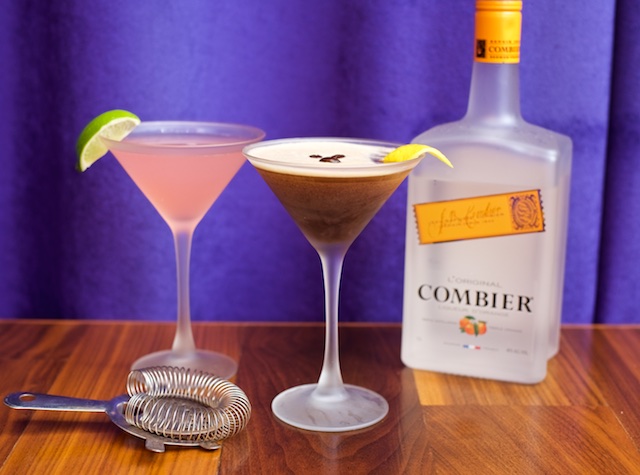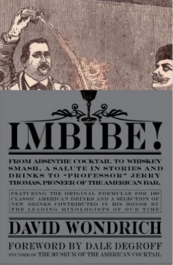A Short History Of The Retro Cocktail: Post Prohibition Recipes

Bartenders, especially those involved in the “cocktail” world, understand the significant impact that Prohibition has had on the industries surrounding alcoholic beverages. Many consumers, however, are unaware of that impact. National Prohibition was rooted in political and religious belief systems, that sought to temper a vice, and legislate morality to a nation. Any time a product, that is in high consumer demand, is made illegal, a black market is created. Crime increases, violence increases, and eventually, the public demands action. It didn’t take long for the ridiculous idea to be repealed, and when Prohibition ended on December 5, 1933, the nation joined together in a collective sigh of relief, and a toast to better times ahead.
Treatises have been written, documentaries have been filmed, and many a scholar has spoken about the nearly decade and a half that The United States of America suffered under the tyranny of Prohibition. What is sorely missing, however, is a definitive study of the decades following its repeal. And, maybe, that is because not much is ever said, outside of our small circle of bartenders, about what life in this industry was like before Prohibition was passed.

In 2007, cocktail historian (yes, that’s a thing) David Wondrich published the book, “Imbibe,” about the history of the bartending profession, and the development of mixed drinks, up to around the time of the early twentieth century. Since then, hundreds of books have been written about the early times of the bar business, and many others containing massive amounts of recipes from that time. The history of the bartender, as a professional, career-minded individual, is no longer disputed. And there’s an equal amount of reference one can obtain about the so-called “Cocktail Revolution” of the latter half of the same century. Many people credit Dale Degroff and his time at New York City’s “The Rainbow Room,” as the start of the resurgence. It may seem pedestrian today, when one can order a margarita, with fresh squeezed lime juice, in LaGuardia Airport. But during Dale’s time, fresh juice was not only taboo, it was essentially unavailable. It took his pioneering vision, and a plethora of disciples, to reinvigorate our industry, and essentially take it back to its roots.
The result of this, thirty years later, is the emergence of folks like me, who can, again, make a career out of mixing, and talking about, alcoholic beverages. All over the country, cocktails are again not just being taken seriously, but are becoming a necessity in competition with other on-premise establishments. A restaurant is now doing a disservice to its clientele, if the beverage program is not on par with the one across the street. Owners, chefs, and managers, are realizing the need for talent not just behind the bar, but around it as well. Talented bartenders are now expected to not just know how to build and stir a Manhattan, but how to make it profitable for the business to sell, in the first place. We have truly come full circle.
But, there’s a large portion of this story that didn’t make it into the proverbial dossier. What about the five decades between the end of Prohibition, and Dale Degroff’s legendary rediscovery of the craft? Surely we agree that bartenders still existed during this half of a century, so what were they doing, and why were they doing it? As a group, we collectively call this period the Dark Ages.

It is estimated that at the end of the nineteenth century, there were over 4000 breweries in the United States. By the early 1930’s, there were merely a handful. While there was a strong bump, following repeal, most of the market was controlled by what would become the large “macro” companies, Bud, Miller, and Coors. By 1979, there were a total of 44 breweries operating in the United States. The same can be said for distilleries. Prohibition nationalized all of the distilled alcohol produced in the country, and the only alcohol that could be sold to the public was marketed as elixirs for “health benefits.” This had the effect of consolidating all of the distilled spirits under the control of a few large companies, as well. Moving into the war and post-war eras, alcoholic beverages followed the same mega-industrial trends as food. The same family that heated up TV dinners for supper, and ate Sara Lee cheesecake for dessert, also drank Smirnoff vodka, and Seagrams Whiskey. A few major brands dominated the market, and the demand for “mixers” was minimal. A bar could be expected to carry a dry and a sweet vermouth, and maybe some “schnapps,” but the days of artisanal Crème de Violette, were over.
So what happened? TGI Fridays happened. Applebee’s happened. Chili’s happened. And the club scene in the large cities happened. While drinks like the Manhattan, and Old Fashioned, had survived Prohibition (at least in a somewhat bastardized form) drinks like the Martini were now of national relevance. One need only to catch a few episodes of Mad Men, to see how the vodka martini began to be the American drink of choice. And, like all good, trends, everyone latched onto it. The public began to move away from drinks that tasted overly like alcohol. Soon, every mixed drink served “up” in a coupe-typed glass, was being called a “martini.” The drink took on the shape of the glassware, rather than the historical recipe for the drink. The style of the 1970’s led to the coupe taking on a more angular, triangle shape, and the “martini glass” was born (I’ll leave the subject of wine coolers to a different post.)
Every generation eschews the practices of the previous one. Soon, brown liquor drinks, like the Manhattan, were being passed over for neon-colored martinis, of various flavors. Large liquor manufacturers were quick to develop product lines of artificially-colored and flavored liqueurs that were meant to approximate real mixing ingredients of the past. You can still see this today, with examples like Hiram Walker, Bols, and Dekuyper, all having various pros and cons to their formulas. The Apple Martini, The Chocolate Martini, The Pineapple Upside Down Cake Martini…. All of these drinks were born in the fern bars and clubs of the 1970’s and 1980’s. The youth was wild, the hook-up game intense. And things would remain this way until Dale Degroff solved all of the world’s problems at The Rainbow Room. Right?
Let’s start from the premise that nothing’s changed. Ever. There have always been two people in the world. One, those who want to drink alcohol, and love the taste of alcohol. And two, those who want to get drunk, and don’t love the taste of alcohol. If you don’t want to drink alcohol at all, I don’t trust you, you’re strange and probably dangerous. But for everyone else, you either sip a nice bourbon, or you mix it with ten ounces of Coca-Cola, and drink it through a straw. There’s really no other option.
So, what are cocktails, exactly, other than a way to make an alcoholic ingredient more palatable? Whether its lightly “seasoning” your whiskey with a cube of sugar, and a few dashes of bitters, or drowning raspberry vodka in a pint glass of Sprite, we’re kind of chasing after the same thing, are we not? At the end of the day, if you want a pint of neon green liquid, served in a triangle suitcase, that tastes like an apple Jolly Rancher on steroids, shouldn’t I be just as willing to accept your twelve dollars in return for it, as I would be in any other instance? Let’s face it, making an Apple Martini, and making a Negroni, are only differed by the skill set needed to master either one. If you can make one, and not the other, then I condemn you for not rounding out your talents. If you can spend three minutes crafting a Mahattan, using local, organic, artisanal, overproof Rye, but you can’t get a customer a vodka soda within ten seconds, while a DJ pumps remixed house beats in your ear, then my thoughts are that you’d better work on that.
At the end of the day, there are no differences in the title ascribed to any of these people. All of them are bartenders, they’re just using different skill sets, depending on the location in which they happen to be working, at the given time. To hear a bartender at a local dive criticize the bartender at an upscale restaurant, or the other way around, is childish, petty, and unnecessary. That being said, there are those who succeed and fail at any of these skill sets. I’ve met incredible bartenders at clubs, and terrible bartenders at world famous cocktail bars, and vice versa. However, the days of the arrogant, dismissive, bartender, who looks down her nose at someone else doing exactly the same job, but in a different way, should be over. We should be holding ourselves more accountable. And I’m looking at you, clubtender who thinks “craft” cocktails are elitist and corny, all while sipping your fresh kale smoothie, that you paid eight dollars for, at the gym.
The fact is, there were people drinking a multitude of different alcoholic beverages in 1820, and there are people drinking a multitude of different alcoholic beverages now. Our job is to make whatever drink they would like, quickly, efficiently, and consistently, every time, while we continue to push ourselves to be pioneers in our field, develop new recipes and new techniques, and learn how to increase sales, and save money. We owe this responsibility to our business, our industry, and ourselves.
Cheers!
The Cosmopolidrop (Chris Faber, Lot No. 3, Bellevue, Washington)
1.5oz Vodka
.5oz Cointreau
.75oz Spiced Cranberry Syrup
Cover fresh cranberries with water in a saucepan.
Add cloves, cinnamon, and nutmeg
Simmer until cranberries pop, and flavors are integrated
Strain solids and mix with an equal part of white sugar
.75oz Lemon
.25oz Unsweetened Cranberry Juice
Shake with ice and double strain up, into a coupe
Garnish with a lemon wheel
The Espresso Martini (Adam Patrick, Match 2014 recipe)
1.5oz Vanilla Vodka
1oz fresh, chilled, espresso
.5oz Borghetti espresso Liqueur
.25oz 2:1 simple syrup
½ an egg white
Shake with ice, strain out, dry shake, double strain up, into a coupe
Garnish with a lemon peel
























